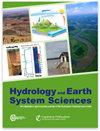Calibration of groundwater seepage against the spatial distribution of the stream network to assess catchment-scale hydraulic properties
IF 5.8
1区 地球科学
Q1 GEOSCIENCES, MULTIDISCIPLINARY
引用次数: 0
Abstract
Abstract. The assessment of effective hydraulic properties at the catchment scale, i.e., hydraulic conductivity (K) and transmissivity (T), is particularly challenging due to the sparse availability of hydrological monitoring systems through stream gauges and boreholes. To overcome this challenge, we propose a calibration methodology which only considers information from a digital elevation model (DEM) and the spatial distribution of the stream network. The methodology is built on the assumption that the groundwater system is the main driver controlling the stream density and extension, where the perennial stream network reflects the intersection of the groundwater table with the topography. Indeed, the groundwater seepage at the surface is primarily controlled by the topography, the aquifer thickness and the dimensionless parameter K/R, where R is the average recharge rate. Here, we use a process-based and parsimonious 3D groundwater flow model to calibrate K/R by minimizing the relative distances between the observed and the simulated stream network generated from groundwater seepage zones. By deploying the methodology in 24 selected headwater catchments located in northwestern France, we demonstrate that the method successfully predicts the stream network extent for 80 % of the cases. Results show a high sensitivity of K/R to the extension of the low-order streams and limited impacts of the DEM resolution as long the DEM remains consistent with the stream network observations. By assuming an average recharge rate, we found that effective K values vary between 1.0×10-5 and 1.1×10-4 m s−1, in agreement with local estimates derived from hydraulic tests and independent calibrated groundwater model. With the emergence of global remote-sensing databases compiling information on high-resolution DEM and stream networks, this approach provides new opportunities to assess hydraulic properties of unconfined aquifers in ungauged basins.根据水系的空间分布校正地下水渗流,以评估流域尺度的水力特性
摘要在集水区尺度上的有效水力特性评估,即由于通过流计和钻孔的水文监测系统的稀疏可用性,因此,水力电导率(K)和透射率(T)的研究尤其具有挑战性。为了克服这一挑战,我们提出了一种仅考虑数字高程模型(DEM)和河流网络空间分布信息的校准方法。该方法是建立在地下水系统是控制河流密度和延伸的主要驱动力的假设之上的,其中常年河流网络反映了地下水位与地形的交集。实际上,地表地下水渗流主要受地形、含水层厚度和无量纲参数K/R控制,其中R为平均流量。在这里,我们使用一个基于过程的简化的三维地下水流动模型,通过最小化由地下水渗流区产生的观测和模拟流网络之间的相对距离来校准K/R。通过在法国西北部的24个选定的水源集水区部署该方法,我们证明该方法成功地预测了80%的河流网络范围。结果表明,只要DEM与河流网络观测值保持一致,K/R对低阶河流的扩展具有很高的敏感性,并且DEM分辨率的影响有限。通过假设平均充电率,我们发现有效K值在1.0×10-5和1.1×10-4 m s−1之间变化,与水力试验和独立校准的地下水模型得出的当地估计值一致。随着汇编高分辨率DEM和流网络信息的全球遥感数据库的出现,这种方法为评估未测量盆地的非承压含水层的水力特性提供了新的机会。
本文章由计算机程序翻译,如有差异,请以英文原文为准。
求助全文
约1分钟内获得全文
求助全文
来源期刊

Hydrology and Earth System Sciences
地学-地球科学综合
CiteScore
10.10
自引率
7.90%
发文量
273
审稿时长
15 months
期刊介绍:
Hydrology and Earth System Sciences (HESS) is a not-for-profit international two-stage open-access journal for the publication of original research in hydrology. HESS encourages and supports fundamental and applied research that advances the understanding of hydrological systems, their role in providing water for ecosystems and society, and the role of the water cycle in the functioning of the Earth system. A multi-disciplinary approach is encouraged that broadens the hydrological perspective and the advancement of hydrological science through integration with other cognate sciences and cross-fertilization across disciplinary boundaries.
 求助内容:
求助内容: 应助结果提醒方式:
应助结果提醒方式:


